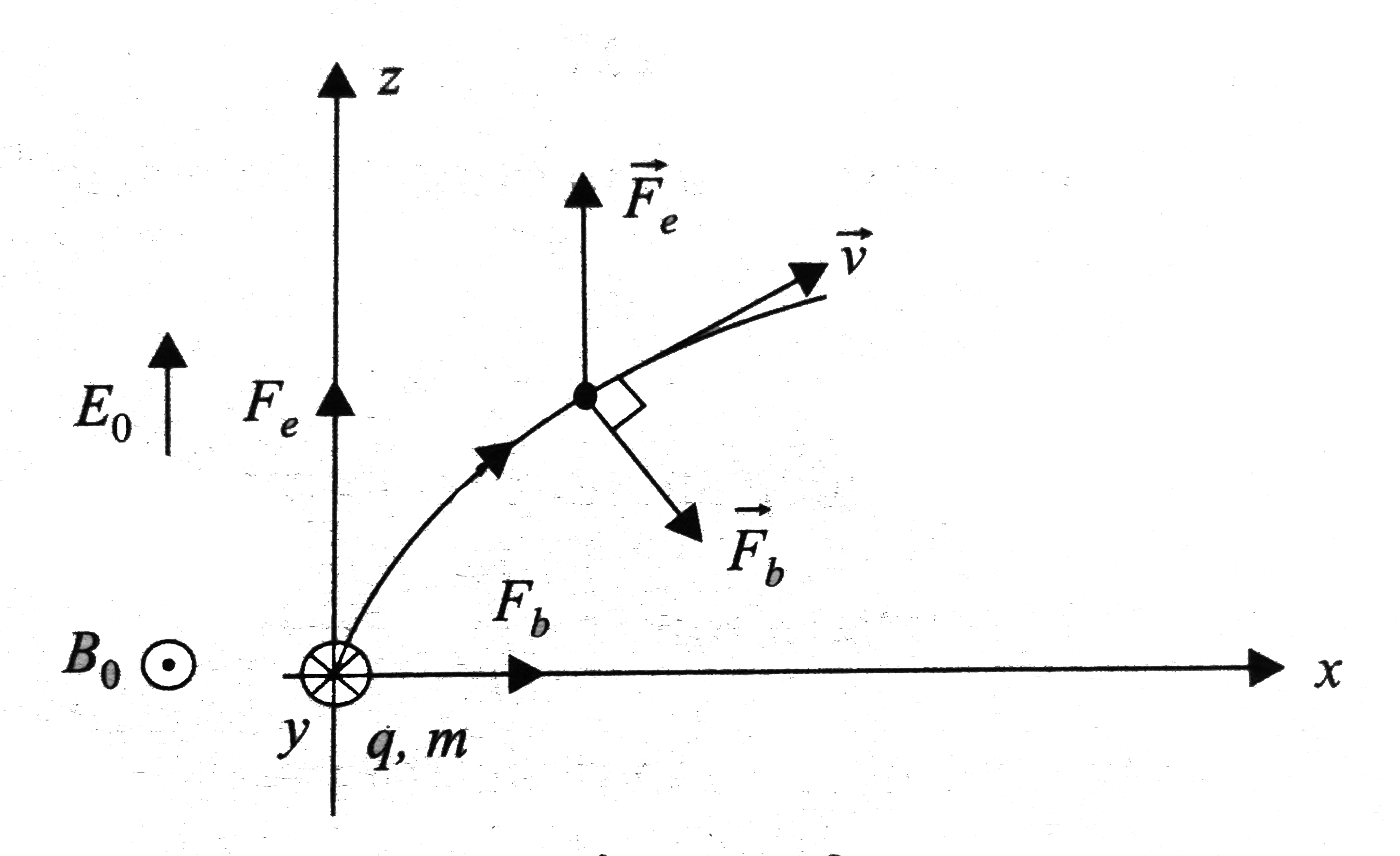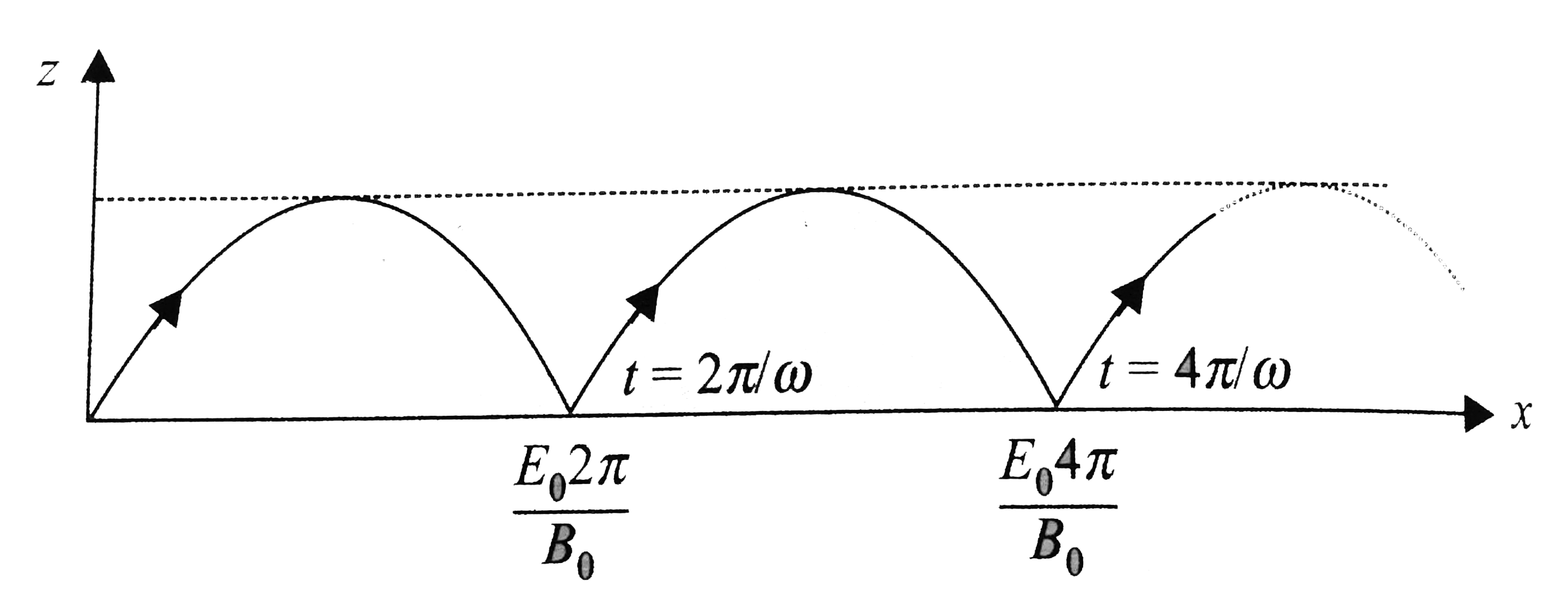A particle having mass m and charge q is released from the origin in a region in which ele field and magnetic field are given by B=−B0ˆjand E=E0ˆk.
Find the y- component of the velocity and the speed of the particle as a function of it z-coordinate.
In Fig shown B0 is outward. As soon as we release the
particle at origin. Electric field will apply force Fe=qE0 on the
particle. Due to this force, the charge particle will gain accelera-
tion and hence velocity along z-axis. And as it gains velocity
along z-axis, then magnetic field will apply the force Fb on charge particle. Now both the forces are always in x-z plane, so
path of charge will be in x-z plane as shown. Let at any time its
velocity is →v=vxˆi+vzˆk. Let →a=axˆi+azˆk is the acceleration
at any time.

Then →F≠t=m→a
⇒qE0ˆk−q(vxˆi+vzˆk)×B0ˆj=m(axˆi+azˆk)
⇒qE0ˆk−qvxB0ˆk+qvzB0ˆi=m(axˆi+azˆk)
⇒max=qvzB0andmaz=q(E0−vxB0)...(i)
⇒mdvxdt=qvzB0andmdvzdt=q(E0−vxB0)...(ii)
From Eq. (ii), dvzdt=qm(E0−vxB0)⇒d2vzdt2=−qB0mdvxdt
⇒d2vzdt2=−qB0mqB0mvz=−(qB0m)2vz
Solution of the above equation is : vz=vz0sin(ωt+ϕ).....(iii)
(where ω=qB0m)
Puting at t=0,vz=0,we≥tϕ=0
Differentiating Eq. (iii),
dvzdt=vz0ωcos(ωt+ϕ)⇒az=ωvz0cosωt
at t=0,az=Fem=qE0m
⇒qE0m=qB0mvz0cos0∘⇒vz0=E0B0
So Eq. (iii) can be written as : vz=E0B0sin(ωt)....(iv)
Puting the value of vz in Eq. (ii), mdvxdt=qE0B0(sinωt)B0
⇒∫v0dvx=∫t0qE0msinωtdt⇒vx=qE0mω[1−cosωt]
⇒vx=qE0m(qB0)/m[1−cosωt]⇒vx=E0B0[1−cosωt]....(v)
Equations (iv) and (v) give velocity as a function of time.
From Eq.(v), dxdt=E0B0(1−cosωt)
⇒∫x0ds=E0B0∫t0(1−cosωt)dt
⇒x=E0ωB0[ωt−sinωt]....(vi)
From Eq.(iv)
dzdt=E0B0sinωt⇒∫z0dz=E0B0∫t0sinωtdt
⇒z=E0ωB0[1−cosωt]....(vii)
Equations (vi) and (vii) give the path of the verticle.
We see that at t=2π
x=E0B02π,z=0

This path is known as cycloided path. This is the same kind of path as followed by a point on the rim of a purely rolling wheel, which is expalined as below.
Let a wheel is rolling purely with angular velocity ω as shown.
Let at t=0, a point P on the rim is at the bottom-most position of
the wheel. After time t, the wheel turns by an angle θ as shown
and point P comes at point P'. Let us find the coordinates of P'.

x=Rθ−Rsinθ=Rωt−Rsinωt=R[ωt−sinωt]...(viii)
z=R−Rcosθ=R[1−cosωt]....(ix)
Equations (viii) and (ix) resemble Eqs (vi) and (vii).
Hence, the resulting path followed by charge is cycloidal.
(b) To find velocity as function of z-coordinate.
From equations (iv) and (v)
v=√v2x+v2z=E0B0√(1−cosωt)2+(sinωt)2
=E0B0√(1−cosωt)2+(1−cosωt)(1+cosωt)
=E0B0√1−cosωt2=E0B0√zωB0E02[FromEq.(vii)]
=
⎷E20B20zqB0mB0E02=√2qE0Zm
Alternate Method to find velocity: Since the magnetic field does
not perform any work, therefore, whatever has been the gain in
kinetic energy it is only because of the work done by electric
field. Applying work-energy theoram, WE=ΔK
⇒qE0z=12mv2−0orv=√2qE0Zm
Topper's Solved these Questions
- BOOK - CENGAGE PHYSICS ENGLISHCHAPTER - MAGNETIC FIELD AND MAGNETIC FORCESEXERCISE - Exercise 1.122videos
MAGNETIC FIELD AND MAGNETIC FORCES
- BOOK - CENGAGE PHYSICS ENGLISHCHAPTER - MAGNETIC FIELD AND MAGNETIC FORCESEXERCISE - Exercise 1.213videos
MAGNETIC FIELD AND MAGNETIC FORCES
- BOOK - CENGAGE PHYSICS ENGLISHCHAPTER - MAGNETIC FIELD AND MAGNETIC FORCESEXERCISE - Multiple Correct Answer type2videos
MAGNETIC FIELD AND MAGNETIC FORCES
- BOOK - CENGAGE PHYSICS ENGLISHCHAPTER - INDUCTANCEEXERCISE - Concept Based8videos
INDUCTANCE
- BOOK - CENGAGE PHYSICS ENGLISHCHAPTER - MISCELLANEOUS VOLUME 3EXERCISE - True and False3videos
MISCELLANEOUS VOLUME 3
Similar Questions
A particle having mass m and charge q is released from the origin in a region in which electric field and magnetic field are given by
→B=−B0→Jand→E−E0→K.
Find the speed of the particle as a function of its z-coordinate.View SolutionA particle of mass m and charge q is thrown in a region where uniform gravitational field and electric field are present. The path of particle:
View Solution
Knowledge Check
- Question 1 - Select One
A particle of mass m and charge q has and initial velocity →v=υ0ˆj. If an electric field →E=→–––(0)ˆi and magnetic field →B=B0ˆi act on the particle, its speed will double after a time :
At=2mv0qE0Bt=2B0qmv0Ct=√3B0qmv0Dt=√3mv0qE0
A particle having charge q moves with a velocity v through a region in which both an electric field →E and a magnetic field B are present. The force on the particle is
View SolutionA particle of mass m and positive charge q is projected with a speed of v0 in y–direction in the presence of electric and magnetic field are in x–direction. Find the instant of time at which the speed of particle becomes double the initial speed.
View SolutionA particle is released from the origin with a velocity vˆe(i). The electric field in the region is Eˆe(i) and magnetic field is Bˆk. Then
View SolutionA particle of charge q and mass m released from origin with velocity →v=v0ˆi into a region of uniform electric and magnetic fields parallel to y-axis. i.e., →E=E0ˆjand→B=B0ˆj. Find out the position of the particle as a functions of time
Strategy : Here →E∣∣→B
The electric field accelerates the particle in y-direction i.e., component of velocity goes on increasing with acceleration
ay=Fym=Fem=qE0m
The magnetic field rotates the particle in a circle in x-z plane (perpendicular to magnetic field) The resultant path of the particle is a helix with increasing pitch.
Velocity of the particle at time t would be
→v(t)=vxˆi+vyˆj+vzˆkView SolutionA particle of specific charge α is projected from origin with velocity v=v0ˆi−v0ˆk in a uniform magnetic field B=−B0ˆk. Find time dependence of velocity and position of the particle.
View SolutionA charged particle of mass m and charge q is released from rest in an electric field of constant magnitude E. The kinetic energy of the particle after time t is
View SolutionA particle of charge q and mass m starts moving from the origin under the action of an electric field →E=E0ˆiand→B=B0ˆi with a velocity →v=v0ˆj. The speed of the particle will become 2v0 after a time.
View Solution
